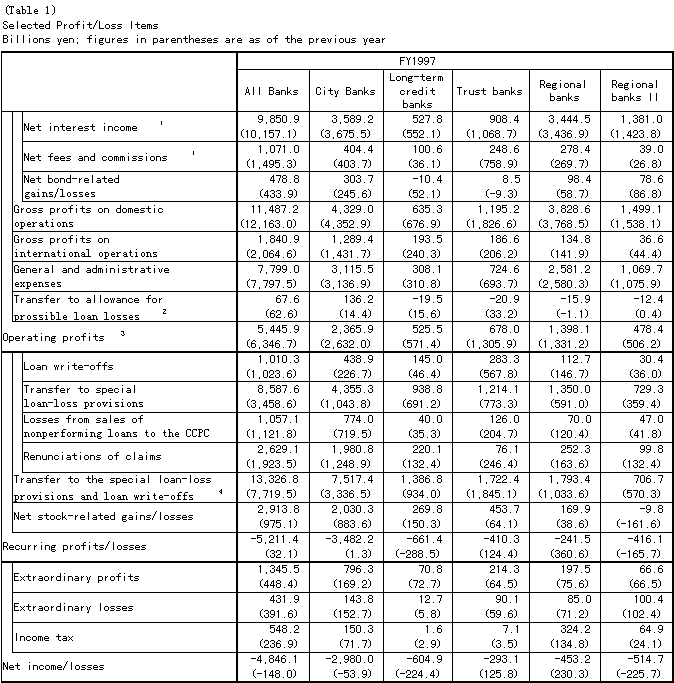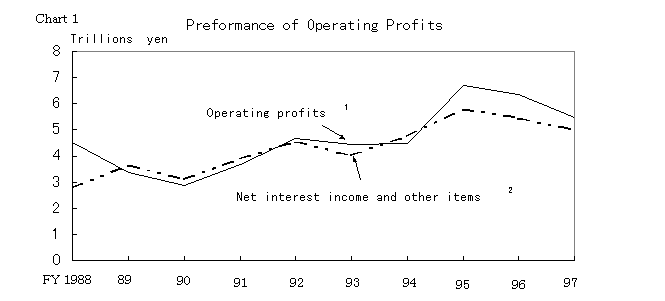Profits and Balance-Sheet Developments of Japanese Banks in Fiscal 1997
- The full text can be obtained from the November 1998 issue of the Bank of Japan Quarterly Bulletin.
November 1998
Bank of Japan
Bank Supervision Department
Overview
Operating profits of Japanese banks in fiscal 1997 amounted to 5.4 trillion yen, down by 14 percent from the previous fiscal year (Table 1).1 This decrease was primarily due to the following factors: (1) the disappearance of a temporary increase in trust fees (income) of trust banks in fiscal 1996; (2) the modest fall in net interest income on domestic operations due mainly to narrowing interest margins; and (3) the slight decrease in gross profits on international operations as a result of the expansion of the "Japan premium" and the downsizing of overseas branches and subsidiaries (Chart 1).2
Transfer to the special loan-loss provisions (SLP) and loan write-offs including those in trust accounts3 amounted to 13.3 trillion yen, which is almost the same figure as the peak recorded in fiscal 1995.4 Due to a considerable amount of transfer to the SLP and loan write-offs, both recurring losses (5.2 trillion yen) and net losses (4.8 trillion yen) marked record highs.5
Risk-based capital adequacy ratios at end-March 1998 at many banks exceeded those at end-March 1997. This improvement was due mainly to banks' efforts to reduce their risk-adjusted assets and various measures taken by the government in December 1997 to stabilize the Japanese financial system.
Although several years have elapsed since the bursting of the economic "bubble," transfer to the SLP and loan write-offs reached levels as high as the peak recorded in fiscal 1995. This reflected the emergence of large corporate bankruptcies and the introduction of a new self-assessment system on banks' asset quality to primarily determine appropriate loan-loss provisioning and loan write-offs under the Prompt Corrective Action (PCA) directives.
One of the key policies for Japanese banks will be to remove nonperforming loans from their balance sheets by such means as selling collateral real estate, in addition to steadily disposing of nonperforming loans and disclosing further information about their business. These efforts could moderate serious impacts of fluctuations in collateral real estate prices on the asset quality of Japanese banks, and thus ensure the reliability of the information included in their balance sheets, and finally restore market confidence in their soundness. In addition, the sales of collateral real estate enable banks to plan flexible management strategies; and reinvestment of the cash inflow from the sales will improve banks' profitability.
- "Japanese banks" refers to All Banks, comprising the member banks of the Federation of Bankers Associations of Japan (Zenginkyo), which consists of 10 city banks, three long-term credit banks, seven trust banks (excluding foreign-owned trust banks and trust banks that started business after October 1993), the 64 member banks of the Regional Banks Association of Japan (referred to as regional banks), and the 64 member banks of the Second Association of Regional Banks (excluding Hanwa Bank, which was liquidated in January 1998; referred to as regional banks II). Figures in this report exclude data for Hokkaido Takushoku Bank, Tokuyo City Bank, and Kyoto Kyoei Bank.
"Operating profits" signifies earnings from core banking operations and is calculated by subtracting "transfer to the allowance for possible loan losses," "general and administrative expenses," and "debenture issuance expenses" from the sum of "net interest income" (the excess of interest income on such items as loans and securities over interest expenses on such debts as deposits and debentures), "net fees and commissions" (net income on fees and commissions received/paid on funds transfers and other service transactions), "net trading revenue" (applied to banks with trading accounts; gains/losses on transactions for trading purposes such as trading-related derivative transactions and gains/losses on year-end valuation at market or fair value), and "net other operating income" (e.g., net gains related to bond and foreign currency transactions). - The temporary increase refers to profits resulting from the write-back of the special reserve funds held by trust banks. Special reserve funds are accumulated to provide for situations in which the value of a loan trust falls below the amount of the principal. The ratio of required reserve funds to the amount of the principal was lowered from 3 percent to 0.5 percent by a revision of a government ordinance. Trust banks wrote off nonperforming loans in trust accounts, using part of the temporary profits in trust fees. The remainder of the profits was accounted as trust fees included in net fees and commissions in banking accounts.
- In accordance with the Loan Trust Law and the Trust Business Law, trust banks guarantee the principals of banking-type trusts (loan trusts and jointly-managed money trusts). Therefore, loan write-offs in trust accounts are included in the total figures of transfer to the SLP and loan write-offs.
- The amount includes loan write-offs, transfer to the SLP, losses from the sales of nonperforming loans to the Cooperative Credit Purchasing Company (CCPC), and other renunciations of claims.
- Reflecting the fact that banks began to be allowed to value listed stocks at cost, losses from stock write-downs declined significantly. As a result, net stock-related gains increased to 2.9 trillion yen, three times higher than those in the previous fiscal year. Net stock-related gains/losses are calculated by subtracting the sum of losses from stock-selling operations and stock write-downs from gains on stock-selling operations.
Notes:
- Interest income of the following two trust accounts,which is primarily included in net fees and commissions, is included in the net interest income account in this table: loan trusts and jointly-managed money trusts with agreements to compensate for losses on the principal.
- Positive/negative figures indicate a transfer to/withdrawal from the allowance.
- Operating profits are the excess of gross profits over general and administrative expenses and transfer to allowance for possible loan losses. Gross profits are the sum of net interest income, net fees and commissions, net trading revenue,and net other operating income.
- Total of banking and trust accounts.
Notes:
- Operating profits jumped in fiscal 1995 and 1996 due to an increase in gains on sales of bonds and to the write-back of the special reserve funds in trust accounts.
- "NET interest income and other items" indicates operating profits excluding variable items.Net interest income and other items = operating profits - net bond-related gains/losses + write-back of the special reserve funds in trust accouns - loan write-offs in trust accounts.


